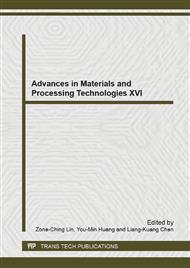p.299
p.305
p.313
p.322
p.328
p.336
p.342
p.349
p.355
Influence of Pre-Generated Infinite Adhesive Defects on the Forming Behaviour of Adhesive Bonded Steel Sheets
Abstract:
In the present investigation, the forming behaviour of adhesive bonded sheets with the pre-generated infinite defects in the adhesive layer is studied. The infinite defects are generated with different orientations like longitudinal, transverse and at an angle of 45°. The base sheet materials used are deep drawing quality steel and SS 316L sheets, and two part epoxy adhesive is used for bonding the base sheet materials. The formability is quantified by monitoring the load-extension behaviour, and limit strain, evaluated through tensile tests and in-plane plane strain (IPPS) formability tests. It is observed that there is a significant decrease in formability because of the presence of infinite defects in the adhesive layer. While comparing the formability of adhesive bonded blanks with respect to different orientations, transversely oriented defect shows more reduction than 45° and longitudinal cases. There is not much difference between the transversely oriented and 45° oriented infinite defects in tensile tests, whereas in the IPPS formability test results, there is no considerable difference between 45° and longitudinally oriented defect.
Info:
Periodical:
Pages:
328-335
Citation:
Online since:
May 2014
Authors:
Price:
Сopyright:
© 2014 Trans Tech Publications Ltd. All Rights Reserved
Share:
Citation:


